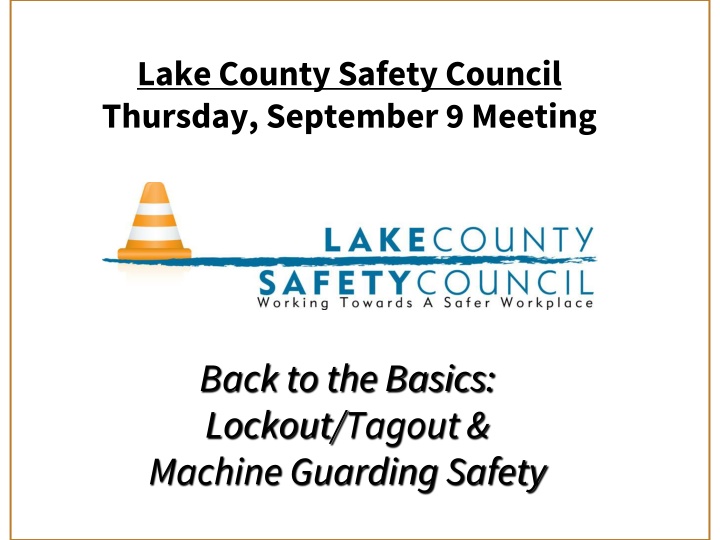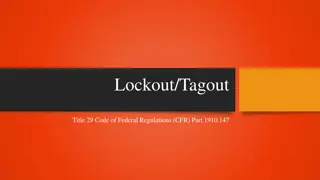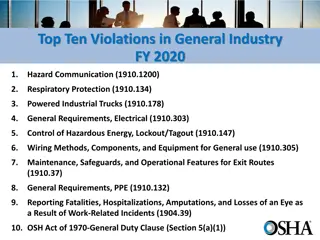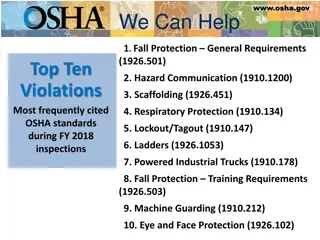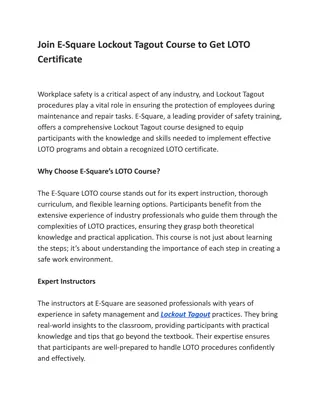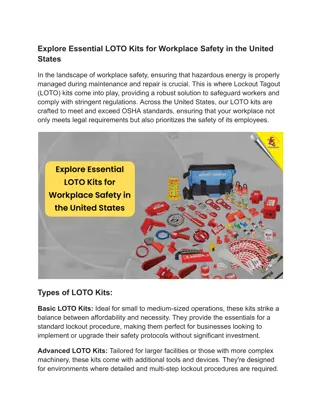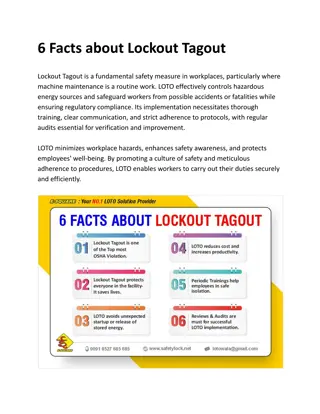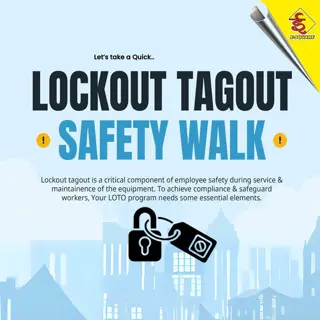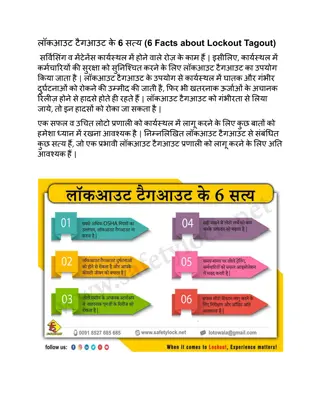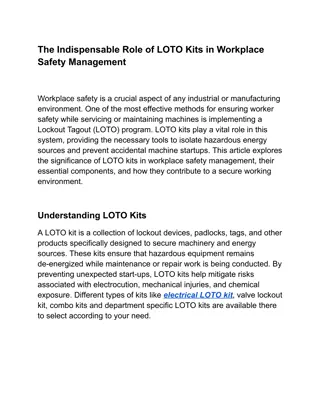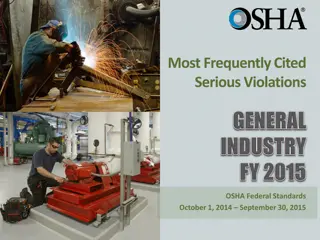Lake County Safety Council Meeting: Lockout/Tagout & Machine Guarding Basics
This Lake County Safety Council meeting on Thursday, September 9, will focus on the basics of Lockout/Tagout (LOTO) and Machine Guarding safety practices. The event will cover topics such as OSHA LOTO process review, LOTO program management, and basics of machine guarding. The purpose of the standard 29 CFR 1910 is to prevent workplace injuries during service and maintenance operations. Attendees will learn when LOTO applies and the importance of machine-specific procedures for each piece of equipment. Event sponsors include HzW Environmental Consultants and Lake Health Occupational Services.
Download Presentation

Please find below an Image/Link to download the presentation.
The content on the website is provided AS IS for your information and personal use only. It may not be sold, licensed, or shared on other websites without obtaining consent from the author.If you encounter any issues during the download, it is possible that the publisher has removed the file from their server.
You are allowed to download the files provided on this website for personal or commercial use, subject to the condition that they are used lawfully. All files are the property of their respective owners.
The content on the website is provided AS IS for your information and personal use only. It may not be sold, licensed, or shared on other websites without obtaining consent from the author.
E N D
Presentation Transcript
Lake County Safety Council Thursday, September 9 Meeting Back to the Basics: Lockout/Tagout & Machine Guarding Safety Picture
Event Sponsor HzW Environmental Consultants Picture
Event Sponsor Lake Health Occupational Services Picture
Event Sponsor Lake Health Occupational Services Picture
LOTO AND MACHINE GUARDING BASICS Welcome 5
COURSE AGENDA The following topics will be covered as part of this training: General review and discussion of the OSHA LOTO process LOTO program management Basics of machine guarding
PURPOSE OF THE STANDARD 29 CFR 1910.147 29 CFR 1926.417 OSHA - To prevent the unexpected energization or startup of machines and equipment, or release of stored energy, to prevent workplace injuries during service and maintenance operations.
WHEN DOES LOTO APPLY? During servicing or maintenance activities performed during normal production operations if: An employee is required to remove or bypass machine guards or other safety devices; An employee is required to place any part of his/her body into a machine s danger zone; Tasks performed near other moving equipment; or if Maintenance or service tasks require close proximity to a guarded hazard area, while there is still potential for contact with the hazardous area of the machine (ex: loose clothing/hair falling into machine).
MACHINE SPECIFIC PROCEDURES Required for each piece of equipment or machine. Must be accurate and up to date. Points out each source of energy, the quantity, and where you release the energy and place the LOTO equipment. It s helpful to have a resource available when developing these such as a maintenance employee.
ZERO ENERGY Zero energy: Condition where all supplied and stored energy is removed, relieved, or blocked. Potential energy can be converted to kinetic!
COMMON LOTO FAILURES Employees do not lock out all isolation points or disconnects Not enough lockout hardware is available for proper lockout/tagout Lockout equipment is not feasible for given isolation points or disconnects Not every employee participates in group lockout/tagout Energy control procedures are not developed
LOTO PROCESS Notify affected employees Shutdown equipment Isolate equipment Perform service and maintenance work Apply LOTO hardware Restarting equipment Return to operation
EMPLOYEE TRAINING Authorized: Trained to perform LOTO. Trained in the purpose and use of the energy control procedure Trained in the recognition of applicable hazardous energy sources. Trained in the methods and means necessary for energy isolation and control. Affected: Trained in what to do when LOTO impacts their job. Instructed that attempts to restart or re-energize machines or equipment that is locked out is prohibited. Typically instructed in the limitations of their training (affected employees are not authorized to perform LOTO).
CONTINUAL PROGRAM MANAGEMENT Energy Control/LOTO Program should include the following: 1. Energy control procedures for every type and piece of equipment 2. Employee training as appropriate 3. Periodic assessments/reviews of authorized employees at least annually 4. Regular reviews of written LOTO procedures 5. Adequate supply of LOTO hardware 6. Develop and follow a LOTO removal policy
Three main categories of guarding: Barrier Device Proximity MACHINE GUARDING Not all equipment will have simple guarding solutions or easy fixes. NOTE: Manufacturers are not required to fully guard equipment that they sell to you!
Barriers Physical barrier to stop employees from reaching a hazard area (can be fixed or adjustable) Device GUARDING TYPES Production controls or devices to stop machine (two-hand trip, light curtains, trip wire, etc.) Proximity Only applies vertically for unprotected fan blades (7 above walking working surface)
MACHINE GUARDING PURPOSE Guarding is designed to permit the safe use of the equipment while preventing employee contact with hazard areas. Point of operation Rotating parts Access to other hazards Any equipment designed for a fixed location must be anchored or secured.
SPECIAL CONSIDERATIONS AND TIPS Perform assessments of each piece of equipment. Evaluate for gaps in guarding that go beyond production or point of operation exposures. Determine which exposures are production related or maintenance/service work. Train employees to evaluate equipment for guarding concerns. Provide tools or devices to keep employees hands away from hazard areas.
